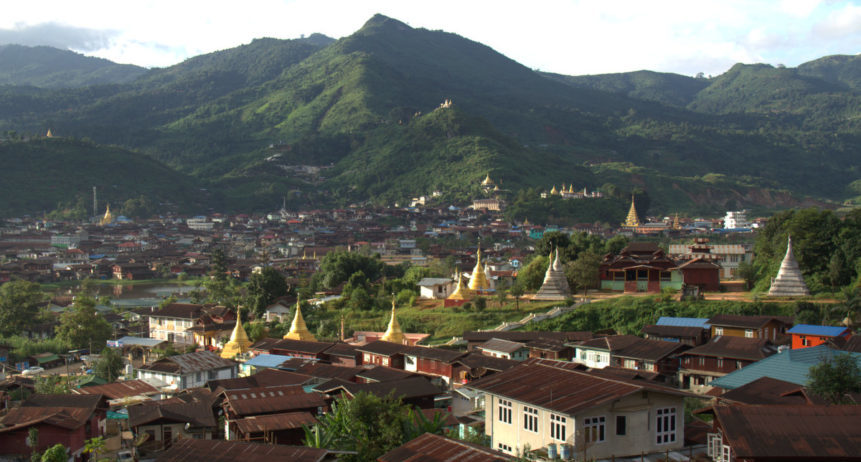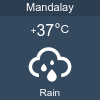Mandalay
Mogok Township
- Details
- Hits: 2908
 Mogok Township
Mogok Township
Photo Credit - www.mineralienatlas.de
info Mogok Township covers an area of 455 square miles, at an elevation ranging from 3800 to 4700 feet. The 128-mile road from Mandalay passes through beautiful mountains and deep, lush valleys offering spectacular scenery with virtually no villages.
The Burmese royal cities had official names that glorified the kingdom, such as City of Gems and Hill of Gems, but Mogok is literally the Town of Gems where many different precious stones can be found in high quantity and quality. Gems from Mogok, especially rubies, are known and desired all over the world. Mogok rubies possess a red florescence within their depths, making them glow as from other countries or even from Maing Shu, another ruby mine in Myanmar. It is noticeable even to the naked eye.
monetization_on Entry Fees: n.a.
watch_later Operation hours: n.a
hourglass_full Time needed: Approximately 3 hour
Chronicles from the 6th century mentioned that a feudal prince paid an anuual tribute of nearly 3 pounds of rubies to the king of one of the Pyu kingdoms. About 800 years later, the first Western merchants arrived in Myanmar, all of whom came to trade in rubies. They mentioned the abundance of rubies seen at court or in the hands of local merchants, all mined from a place they called variously Capelam, Capelan, Caplan or Capellan, which was obviously a reference to Kyatpyin, a town that now adjoins Mogok.
Between 1502 and 1508, Italian adventurer Ludovico di Varthema visited Bago, which at that time was the royal capital of Hanthawaddy, and met King Nanda Bayin. The Italian wrote of the king, "He wears more rubies on him than the value of a very large city, and he wears them on all his toes." Italian Jesuit priest Pere Giuseppe d'Amato was the first European to visit Kyatpyin in 1833, and his posthumously published book was the first eyewitness account of the ruby mines by a foreigner.
In early 1884, a French engineer arrived in Mandalay to solicit the king for a permit to mine at Mogok. A spy at the court told the British about this meeting, but what the British did not know was that the deal was never made. However, many historians believe that it was fear of losing this concession to France that compelled the British to invade and colonise Myanmar in November of the following year. The British company Burma Ruby Mines Ltd worked Mogok from 1889, but a series of difficulties led to bankruptcy in 1934. The large lake in the centre of Mogok was formed when the mines worked by the Burma Ruby Mines flooded.
The old methods of mining with shovels and picks disappeared about 20 years ago, and now visitors can see and hear noisy machinery at work. The leftover mud and pebbles that are sieved and searched for gemstones are sold to women and children, who again look for tiny stones to sell to artists who make gem paintings. These paintings first appeared on the souvenir market at around at the same time as the machines were put into use.
Even while using modern techniques, the miners have not discarded the old ways. There are seven spirit shrines in Mogok, where each year in June and December - on either a Tuesday or Saturday - miners offer fruits and rice cakes at dawn. If they work as a team, they can send people to different shrines. The most revered is the shrine of Grandfather Spirit who looks after all of Mogok, while each of the other six spirits look after a particular neighbourhood. People in Mogok are superstitious because many fortunes have been made through sheer luck, and many lost through carelessness. One group of poor miners sold a cluster of brown crystals to a famous merchant for "enough cash to buy us this evening's round of drinks" - but an 8-carat stone of fair quality was discovered inside that fetched 240 times the amount paid to the men. Even primary schoolchildren in Mogok carry packets of inexpensive gems wrapped in the most professional manner in two layers of paper, which they show each other and compare quality. Thus they learn at an early age how to judge value, and even to know the right times of day to view a gem as the colour changes according to the sunlight and the atmosphere.
Looking for rubies, trading them, polishing them and learning about them are all part of normal life in Mogok. It is not surprising that tar pwe (temporary markets) spring up every day, as well as at five-day markets in villages far from town. The tar pwe last barely two hous and most do not overlap. The biggest occurs around noon every day in the eastern part of town in Peik Swei Ward. Plastic tables and chairs shaded by large standing umbrellas are set up in an empty lot. Traders sit at the tables, while brokers walk around enticing visitors to look at the gems that they carry inside folded paper packets. Everyone has a small flashlight and a loupe, or magnifying eyepiece, to check the quality. Naturally, the best gems are not sold here because those deals are done in private. However, the value of gems seen here can be high: The asking price for a 5th-grade ruby the size of a small pea is about US$5000.
The best place to look over this quiet, gentle town of gems is from the View Point, from which the high mountains surrounding town can be seen rising from the early morning mist. The platform of Ruby Pagoda, also known as Lay Myet Hna Paya, also provides a great view. In the centre of town is beautiful Hpaung Daw Oo Pagoda, which is home to old images and two thrones that are only taken out on specific religious days; one is made from gold and one from silver, and both are richly embellished with huge, high-quality rubies.
Daw Nan Kyi Taung Pagoda is named after the sister of Nga Mauk, a miner who smuggled out a huge rube he had found instead of presenting it to the king as the law decreed.As a result, his whole family was executed. Daw Nan Kyi fled across the mountains but paused to look back at her family's burning homes. The pagoda marks the place where she died of a broken heart. Kyautk Pyatthat Pagoda consists of several stupas set along the side of a high hill and connected by walkways. When seen from afar, the crowns of the spires and the tiered roofs of the walkways look like the abode of celestials.
Ethnic groups living in and around Mogok keep their traditions alive. The Shan have their New Year around December, as well as six other annual religious celebrations. Lisu Christians celebrate Christmas in their villages, but every three years they pick one village to hold combined celebrations. As many as 10,0000 attendees, including those returning from abroad and from other towns in Myanmar, pray, feast and celebrate for three days. Lisu Buddhists also hold religious and traditional festivals. They celebrate their New Year around January, the Harvest Festival in August, and two other celebrations in September and December. The Palaung hold three Buddhist festivals from July to October marking the beginning, middle and end of the Lent period, and they also celebrate a bonfire festival around February. Mogok is rich not only in gems but also in the diversity, goodwill and truly delightful friendliness of the townspeople.
(The writer and photographers are hugely indebted to U Tun Oo of Natural Beauty Gems and Gem Paintings in Mogok for sharing his knowledge and time.)
build Year established: n.a.
directions Directions:
place Location: Mogok, Mandalay Region, Myanmar
local_phone Phone: n.a.
email Email: n.a.
public Website: n.a.
local_taxi Estimated taxi fare: n.a.
directions_bus Bus directions: n.a.
directions_railway Circular train: n.a.
map See map below:
help_outline Get a free quotation for a Myanmar tour to visit this place.
grade Give a star-rating on this place or write a FB comment below:







